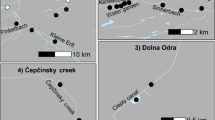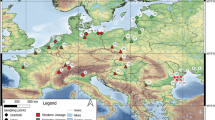Abstract
Due to their shallow and confined nature, lagoons provide excellent conditions for the transmission of digenean trematode parasites that require two or more intermediate hosts for the completion of their complex life cycles. However, these unstable environments are characterised by an internal heterogeneity and a large variation of a range of abiotic variables. We conducted a series of experiments in a comparative framework to assess the effect of a number of exogenous factors known to exhibit marked fluctuations in the lagoonal environment, i.e. temperature, salinity, water level and photoperiod, on larval emergence of two sympatric parasites, Cainocreadium labracis and Macvicaria obovata, which share the snail intermediate host, Gibbula adansonii, and a sit-and-wait downstream host-finding strategy. Our results demonstrated contrasting patterns and rates of larval emergence indicating an overall differential response of the two species to the variation of the environmental factors. Cercariae of M. obovata exhibited increased emergence rates at elevated temperature (with a sharp increase at 15 °C), decreased salinity (35–25 practical salinity units (psu)) and low water levels, whereas larval emergence of C. labracis was unaffected by the experimental variation in temperature and water level and showed decreased rates at decreased salinity levels (35–25 psu). The differential impact of the variable environmental conditions indicates the complexity of the patterns of exogenous control modifying parasite transmission and abundance in the lagoonal environment. Most importantly, the contrasting rhythms of larval emergence indicate endogenous control associated with the different transmission pathways of the two opecoelid digeneans.






Similar content being viewed by others
References
Barbone E, Rosati I, Reizopoulou S, Basset A (2012) Linking classification boundaries to sources of natural variability in transitional waters: a case study of benthic macroinvertebrates. Ecol Indic 12:105–122
Bartoli P, Gibson DI (2007) Synopsis of the life cycles of Digenea (Platyhelminthes) from lagoons of the northern coast of the Western Mediterranean. J Nat Hist 41:1553–1570
Basset A, Galuppo N, Sabetta L (2006) Environmental heterogeneity and benthic macroinvertebrate guilds in Italian lagoons. Transit Waters Bull 1:48–63
Bell AS, Sommerville C, Gibson DI (1999) Cercarial emergence of Ichthyocotylurus erraticus (Rudolphi, 1809), I. variegatus (Creplin, 1825) and Apatemon gracilis (Rudolphi, 1819) (Digenea: Strigeidae): contrasting responses to light:dark cycling. Parasitol Res 85:387–392
Born-Torrijos A, Kostadinova A, Raga JA, Holzer AS (2012) Molecular and morphological identification of larval opecoelids (Digenea: Opecoelidae) parasitising prosobranch snails in a Western Mediterranean lagoon. Parasitol Int 61:450–460
Camp J, Delgado M (1987) Hidrografía de las bahías del delta del Ebro. Inv Pesq 51:351–369
Combes C, Bartoli P, Théron A (2002) Foraging for hosts - trematode transmission strategies. In: Lewis EE, Campbell JF, Sukhdeo MVK (eds) The behavioral ecology of parasites. CABI Publishing, Wallingford, pp 1–12
Combes C, Fournier A, Moné H, Théron A (1994) Behaviours in trematode cercariae that enhance parasite transmission: patterns and processes. Parasitology 109:S3–S13
Cribb TH (1985) The life cycle and biology of Opecoelus variablis sp. nov. (Digenea: Opecoelidae). Aust J Zool 33:715–728
del Norte-Campos AGC, Temming A (1994) Daily activity, feeding and rations in gobies and brown shrimp in the northern Wadden Sea. Mar Ecol Prog Ser 115:41–53
Evans J, Borg JA, Schembri PJ (2011) Distribution, habitat preferences and behaviour of the critically endangered Maltese top-shell Gibbula nivosa (Gastropoda: Trochidae). Mar Biol 158:603–611
Fingerut JT, Zimmer CA, Zimmer RK (2003) Patterns and processes of larval emergence in an estuarine parasite system. Biol Bull 205:110–120
Galaktionov KV, Dobrovolskij AA (2003) The biology and evolution of trematodes. An essay on the biology, morphology, life cycles, transmissions, and evolution of digenetic trematodes. Kluwer Academic Publishers, Dordrecht
Hesthagen IH (1976) Locomotor activity of the black goby, Gobius niger L. (Pisces, Gobiidae), under artificial conditions, including a false dawn and dusk. Sarsia 62:9–18
Koprivnikar J, Poulin R (2009) Effects of temperature, salinity, and water level on the emergence of marine cercariae. Parasitol Res 105:957–965
Koprivnikar J, Lim D, Fu C, Brack SHM (2010) Effects of temperature, salinity, and pH on the survival and activity of marine cercariae. Parasitol Res 106:1167–1177
Kuris AM, Hechinger RF, Shaw JC, Whitney KL et al (2008) Parasite and free-living biomass in estuaries: implications for ecosystem energetics. Nature 454:515–518
Lei F, Poulin R (2011) Effects of salinity on multiplication and transmission of an intertidal trematode parasite. Mar Biol 158:995–1003
Loker ES (1983) A comparative study of the life-histories of mammalian schistosomes. Parasitology 87:343–369
Maillard C (1971) Developmental cycle of Cainocreadium labracis (Dujardin, 1845) (Trematoda, Allocreadiidae). C R Acad Sci Paris Sér D 272:3303–3306
McCarthy HO, Fitzpatrick S, Irwin SWB (2002) Life history and life cycles: production and behavior of trematode cercariae in relation to host exploitation and next-host characteristics. J Parasitol 88:910–918
Mouritsen KN (2002a) The Hydrobia ulvae–Maritrema subdolum association: influence of temperature, salinity, light, water-pressure and secondary host exudates on cercarial emergence and longevity. J Helminthol 76:341–347
Mouritsen KN (2002b) The Hydrobia ulvae–Maritrema subdolum association: cercarial emergence controlled by host activity. J Helminthol 76:349–353
Mouritsen KN, Jensen KT (1997) Parasite transmission between soft-bottom invertebrates: temperature mediated infection rates and mortality in Corophium volutator. Mar Ecol Prog Ser 151:123–134
Nash RDM (1982) The diel behavior of small demersal fish on soft sediments on the west coast of Scotland using a variety of techniques: with special reference to Leseurogobius frisii (Pisces, Gobiidae). Mar Ecol 3:161–178
Palacín C, Martin D, Gili JM (1991) Features of spatial distribution of benthic infauna in a Mediterranean shallow-water bay. Mar Biol 110:315–321
Pietrock M, Marcogliese D (2003) Free-living endohelminth stages: at the mercy of environmental conditions. Trends Parasitol 19:293–299
Poulin R (2006) Global warming and temperature-mediated increases in cercarial emergence in trematode parasites. Parasitology 132:143–151
Prinz K, Kelly TC, O’Riordan RM, Culloty SC (2011) Factors influencing cercarial emergence and settlement in the digenean trematode Parorchis acanthus (Philophthalmidae). J Mar Biol Ass UK 91:1673–1679
Prokofiev VV (1999) Influence of temperature and salinity on a life span of cercariae of marine littoral trematodes Cryptocotyle sp. (Heterophyidae), Levinseniella brachysoma and Maritrema subdolum (Microphallidae). Parazitologiya 33:520–525 (In Russian)
Rees G (1948) A study of the effect of light, temperature and salinity on the emergence of Cercaria purpuras Lebour from Nucella lapillus (L.). Parasitology 38:228–242
Shostak AW, Esch GW (1990) Photocycle-dependent emergence by cercariae of Halipegus occidualis from Helisoma anceps, with special reference to cercarial emergence patterns as adaptations for transmission. J Parasitol 76:790–795
Southward AJ, Southward EC, Dando PR, Hughes JA, Kennicutt MC, Alcala-Herrera J, Learhy Y (1997) Behaviour and feeding of the nassarid gastropod Cyclope neritea, abundant at hydrothermal brine seeps off Milos (Aegean Sea). J Mar Biol Ass UK 77:753–771
Studer A, Poulin R (2012) Effects of salinity on an intertidal host–parasite system: is the parasite more sensitive than its host? J Exp Mar Biol Ecol 412:110–116
Studer A, Poulin R (2013) Cercarial survival in an intertidal trematode: a multifactorial experiment with temperature, salinity and ultraviolet radiation. Parasitol Res 112:243–249
Studer A, Thieltges DW, Poulin R (2010) Parasites and global warming: net effects of temperature on an intertidal host-parasite system. Mar Ecol Prog Ser 415:11–22
Stunkard HW, Shaw CR (1931) The effect of dilution of sea water on the activity and longevity of certain marine cercariae, with descriptions of two new species. Biol Bull 61:242–271
Thieltges DW (2007) Habitat and transmission–effect of tidal level and upstream host density on metacercarial load in an intertidal bivalve. Parasitology 134:599–605
Thieltges DW, Rick J (2006) Effect of temperature on emergence, survival and infectivity of cercariae of the marine trematode Renicola roscovita (Digenea: Renicolidae). Dis Aquat Org 73:63–68
Thieltges DW, de Montaudouin X, Fredensborg B, Thomas Jensen K, Koprivnikar J, Poulin R (2008) Production of marine trematode cercariae: a potentially overlooked path of energy flow in benthic systems. Mar Ecol Prog Ser 372:147–155
Acknowledgments
This research was partially supported by CTM2006-07/MAR-FEDER Grant, Prometeo/2011/040 project of Generalitat Valenciana (JAR) and the Czech Science Foundation, grant P505/10/1562 (AK). The first author thanks Dr. Juan Antonio Balbuena for his advice during the study. AB is the recipient of a doctoral fellowship (Ministry of Education and Science, Spain; grant AP2009-2560) and a visiting studentship to the Institute of Parasitology (Academy of Sciences of the Czech Republic).
Author information
Authors and Affiliations
Corresponding author
Rights and permissions
About this article
Cite this article
Born-Torrijos, A., Holzer, A.S., Raga, J.A. et al. Same host, same lagoon, different transmission pathways: effects of exogenous factors on larval emergence in two marine digenean parasites. Parasitol Res 113, 545–554 (2014). https://doi.org/10.1007/s00436-013-3686-7
Received:
Accepted:
Published:
Issue Date:
DOI: https://doi.org/10.1007/s00436-013-3686-7




